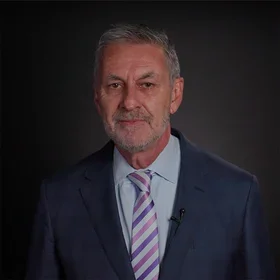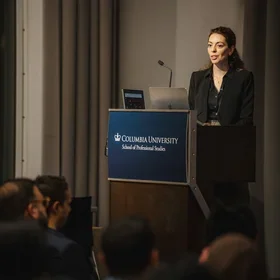By Steven Cohen, Ph.D., Director of the M.S. in Sustainability Management program, School of Professional Studies
Political acts such as war and less dramatic manifestations of national conflict impact global trade and supply chains. Freight shippers typically try to avoid conflict zones. Companies develop strategies to avoid tariffs and taxation. Global warming has begun to have a similar impact on supply chains due to extreme weather events and the impact of climate change on agriculture. The supply needed for production might be destroyed or its transport interrupted. Nevertheless, it is not always possible to connect environmental risk and financial risk. Environmental risk is not easy to understand and is not limited to climate risk. An organization that manufactures, ships, or utilizes toxic substances incurs risks from accidental or even deliberate release of these substances. Individuals, organizations, and jurisdictions that are harmed by toxic releases can sue polluters for the cost of damage, lost income, and cleanup. There are thousands of examples of costly environmental damage, the largest and most prominent were: General Electric’s billion-dollar-plus expense due to PCB pollution in the Hudson River, BP’s 54 billion dollar expense following its oil rig explosion in the Gulf of Mexico, and Northwest Southern’s more recent toxic derailment in East Palestine, Ohio, already exceeding a billion dollars in cost. To summarize, supply chains are an economic necessity but are subject to multiple risks. Some of these risks can be mitigated by insurance, but many are uninsurable. Insurance and reinsurance companies, who are in the business of insuring risk, are learning to price and even avoid environmental risk.
Risks must be measured and understood. For example, hazardous material releases are relatively rare from American freight trains. According to the Federal Railroad Commission, in 2023, 6,686 freight cars carried hazardous materials, 691 were damaged or derailed, and 35 released materials. This is similar to the safety rate in 2015 when 7,903 freight cars carried hazardous materials, 650 were damaged or derailed, and 60 released materials. The data over these years is consistent, but as the disaster in East Palestine, Ohio demonstrated, the potential for a major environmental risk is always present. Like a nuclear accident, the probability may be low, but the impact can be massive.
Investors do not yet know how to factor these risks into their investment decisions, but they are searching for data that will enable them to do this. That is one of the primary motors driving the development of sustainability metrics. Emulating financial accounting with mandatory reporting of sustainability metrics for publicly traded companies would lead to the development of generally accepted sustainability metrics. This would simplify and professionalize both measurement and reporting. The objective for investors is to understand how serious and competent management is at understanding and mitigating these risks. It is impossible to eliminate these risks, but if management is ignoring this source of risk, investors have every right to be nervous.
It is unfortunate that the measurement and reporting of environmental risk has become politicized and considered by some to be outside the purview of the U.S. Security and Exchange Commission. While this will set back the development of uniform reporting requirements in the United States, it will not dampen the demand by investors for this information. States like California and multi-national institutions such as the European Union will move ahead and implement their own reporting requirements, beginning with greenhouse gas emission disclosure. Companies doing business in California and Europe will still need to comply with these rules. Moreover, while environmental risk does not always correlate with financial risk, as environmental risks grow, their financial impact will grow as well.
The risk profile of environmental risk is growing because the probability of being in the pathway of destruction from extreme weather, transport, or manufacturing breakdowns has grown. America’s pattern of development is characterized by a large number of single-family homes, and as the population has grown and has spread out to cover the landscape, extreme weather events and toxic releases that might have missed population centers years ago now hit them. These days, people live closer to forests that might burn and bodies of water that might cause their homes to flood. This increased proximity damages homes and businesses and can impact human health, all of which results in increased financial risk. Decisions to ignore nature when locating a home or business have become more pronounced in the past half-century. Years ago, people did not build their homes as close to the ocean or forest because they respected the power of nature. In our arrogance, we believe we can build structures stronger than nature’s ability to destroy or damage them. While engineering and technology can reduce the risk of environmental damage, it can never eliminate it.
Sustainability management is more thoughtful and mindful management. Data-driven management enables decision-making that more fully projects risk. Modern management uses focus groups and public opinion data to understand consumers and in some cases is able to refine projections to determine the size of production runs. What is key is developing the organizational capacity to develop and conduct measurements, report measures, and analyze the impact of these data on organizational operations. This enables organizations to better understand demand and production processes and estimate the risks incurred during production, distribution, and consumption.
Data and measurement are necessary, but without management who knows how to utilize data, it is far from sufficient. The use of data in decision-making requires that information is shared throughout the organization and that potential problems and risks are exposed to the largest number of people feasible. Managers often try to hide data, particularly information about potential problems. They do this out of a misguided sense of “need to know,” a desire to protect their image, and their tendency to equate control of information with power. Sometimes management hordes negative information due to a delusional hope that the problem will evaporate on its own. Exposure of key performance indicators to middle managers and staff often provides senior management with suggestions on the causes and effects of the data that staff are finally allowed to see. That maximizes the use of information in decision-making, which tends to lead to better, more data-driven, and informed decisions.
Sustainability metrics are a new and vital element of every organization’s key performance indicators. They should be integrated into an organization’s overall performance measurement system and not remain separated from them. Sustainability metrics should also be integrated into management decision-making and not segregated into a separate basket for sustainability decision-making. That said, in 2024, sustainability indicators and management are organizational innovations that, over the next decade or so, will require distinct reporting requirements, annual reports, and likely distinct organizational capacity for sustainability. Investors and regulators are expecting distinct measures and reports, and it makes sense for organizations to respond to these stakeholders.
In the long run, all competent management will be sustainability management. But the meaning and use of indicators of environmental, community, and organizational impact measures will vary by organization. In some respects, this is like financial measures. The rate of return of some investments is lower in some enterprises than in others. That is why you compare financial results among competitors in the same line of business. The carbon footprint and even exposure to extreme weather events is different for a consulting firm and a cell phone company. Cell towers are more vulnerable to damage than a consultant’s highly mobile laptop. The environmental risk of trucking has more in common with freight trains than passenger trains. What is needed in all cases is for management to understand and plan for risk. Before Hurricane Sandy hit New York, transit officials moved subway cars to the highest points in the city to avoid damaging cars due to flooding. That decision enabled the subway system to re-open more rapidly than expected.
Many folks remain nostalgic for a simpler, less complicated time, and there is an urge to return to an imagined earlier era of stability and certainty. Unfortunately for nostalgia buffs, conditions have changed. We have more people, more communication, more transportation, and more consumption than at any time in human history. For many, our daily lives enable us to communicate, travel, be entertained, and live lifestyles that a century ago couldn’t even be imagined. Our economy is huge and complicated, and it requires organizational managers who are more sophisticated and attentive to the world’s impact on their operations and their organizations’ impacts on the world. Government regulation and taxation may serve as a brake on an organization’s freedom of movement, but government’s influence is small compared to market factors and the influence of our changing natural environment. Management must understand sustainability metrics and environmental risk and integrate that understanding into routine decision-making.
Views and opinions expressed here are those of the authors, and do not necessarily reflect the official position of Columbia School of Professional Studies or Columbia University.
About the Program
The Columbia University M.S. in Sustainability Management program offered by the School of Professional Studies in partnership with the Climate School provides students cutting-edge policy and management tools they can use to help public and private organizations and governments address environmental impacts and risks, pollution control, and remediation to achieve sustainability. The program is customized for working professionals and is offered as both a full- and part-time course of study.



